
Kevin Breen, CGCS, has overseen maintenance at La Rinconada Country Club in Los Gatos, Calif., since 2012, after a long stint at Lahontan Golf Club in the Lake Tahoe area. Photo by Adam Weidenbach
When Kevin Breen, CGCS, was the golf course superintendent at Lahontan Golf Club near Lake Tahoe — a course he helped build and grow in — he started most Thursdays by joining a few fellow superintendents from neighboring facilities for a few cups of coffee and a whole lot of conversation.
Sometimes, only a handful were able to make it; other times, there would be as many as 10 or 12 superintendents crowded around small tables at a local coffee shop.
But the numbers mattered far less than the camaraderie and the chatter. They’d share tips and tricks, complain about the weather or know-it-all golfers, commiserate about agronomic challenges and debate issues facing their local superintendent chapter, the Sierra Nevada GCSA, and, more commonly, their national association, GCSAA.
Breen was there for all of it, the good and the bad, the compliments and the complaints. And to him, it didn’t matter much whether the crowd was big or small, or whether the tone of the conversations was positive or negative. These weekly gatherings always delivered something that he has craved throughout his life and his long career in golf course management — a sense of community.
It motivated Breen to join a cycling team during his days at the University of Nebraska, Lincoln. It inspired many of the lifelong relationships he has built over a career that has taken him from the Rocky Mountains to the Bay Area. It stirred in him a drive to join and later serve the superintendent chapters he encountered at each step along the way.
And most recently, his desire to experience a broader sense of community and create the same for others across the industry was among the deciding factors in Breen’s pursuing a spot on GCSAA’s national board of directors, a journey that culminates this year as he serves as the association’s 86th president.
“It’s always really been about the community of all this for Kevin, about developing and having those relationships with his peers,” says his wife of 32 years, Lori Breen.
Breen’s daughter, Lark, recalls similar experiences from her childhood. “My dad always wanted to be on the same page, doing things together,” she says. “Sometimes that meant skiing together on a Saturday morning or going for a hike in the summer. He would be so enthusiastic and eager to get out, it was hard to resist.”
While the 60-year-old Breen makes it clear that there are many factors behind his motivation to serve and give back to the industry, he doesn’t argue that seeking a sense of community is among the most notable.
“I never started with committee service or serving my local chapters with the intention of wanting to become president, whether that was chapter president or GCSAA president,” says the 31-year association member who is now the director of greens and grounds at La Rinconada Country Club in Los Gatos, Calif. “But all along the way, I enjoyed the process. I enjoyed what I was doing, the people I was doing it with, and I enjoyed trying to make things better.”
Focused and forthright
Breen’s predecessor in the role of GCSAA president, Mark Jordan, CGCS, can attest to the positive impact that Breen’s presence has had on the national board of directors since he was elected to that group in 2015.
“You know that when Kevin talks, you’re going to get a thorough, reasoned opinion on whatever it is we’re talking about,” says Jordan, a 35-year GCSAA member. “He has a calm demeanor, he’s a deep thinker, and he listens well. Because of that, he has confidence in himself that he’s considered all the options and has a well-thought-out point of view.”
Those sentiments are shared by those Breen works for and with at La Rinconada, who have seen how his steady hand and attention to detail have benefited the club, located just south of downtown San Jose, and its 18-hole layout since his arrival in 2012.

Breen, his wife of 32 years, Lori, and their dog, Arlo. Photo by Adam Weidenbach
Andy Kimball, La Rinconada’s general manager who was on the hiring committee responsible for hiring Breen, is effusive in his praise of the work Breen has done at the club and is confident the same is on tap for GCSAA and its worldwide membership in 2022.
“Kevin has a demand for quality, an appreciation of high quality and an expectation of those around him to step up and match that,” Kimball says. “As a leader with those kinds of characteristics, you’re going to bring everybody up with you and raise that bar. We’ve seen that here, and I think GCSAA will see that if they haven’t already during his time on the board.”
Jeff Gallinat, a longtime member at La Rinconada and the club’s current president, adds, “I have an admiration for anyone who really practices their craft and genuinely wants to get better, and I definitely see that in Kevin. He’s someone who is highly competent, highly curious, who has a sincere interest in making our club the best it can be while also developing the people who work for him so they can also be the best they can be.”
While that curiosity and drive to excel come naturally to Breen, the desire to serve the industry was grown and nurtured over time. There wasn’t necessarily a long track record of civic leadership or association work in his background, so when Breen joined a few classmates to help form a student GCSAA chapter while pursuing a horticulture and turf science degree at Colorado State University, it represented a new frontier for him.
Soon, he had earned not one but two scholarships from the Rocky Mountain GCSA that supported his schoolwork at Colorado State. Then, he represented CSU in the GCSAA Collegiate Turf Bowl and took in all the Conference and Trade Show had to offer during that trip. He was hooked.
“That tied it all together for him,” Lori Breen observes. “That made it something that mattered.”
Storm chasing
One thing on Breen’s résumé jumps out from his educational background — his first college degree, which had nothing to do with golf or turfgrass management. Instead, the degree he earned from the University of Nebraska was in meteorology.
As someone who spent his formative years in the Midwest, it was an interest he came by honestly. “Storm geek from the beginning,” Breen says. “You grow up in central Kansas, you get to see a lot of severe weather. My mom always hated that I wanted to run outdoors every time there was a tornado instead of heading to the basement.”


Top: A day at Cypress Point with some of Breen’s trail running cohorts — Brian Boyer (left), the superintendent at Cinnabar Hills GC in San Jose, Calif.; Thomas Bastis (second from left), PGA Tour agronomist; and Karl “Speedgoat” Meltzer (right). Bottom: Running is a family affair for the Breens. Kevin is pictured here at the conclusion of the Lincoln, Neb., Half Marathon with his daughter, Natalie, and his mother, Linda. Photos courtesy of Kevin Breen
Breen is one of five children, the son of Patrick and Linda Breen. He was born in the Mississippi River town of Burlington, Iowa, but moved to Salina, Kan., at an early age when his father took a job in wholesale furniture sales. Patrick’s region was the state of Kansas. Salina sits in the dead center of the state, so it became home to Kevin and his four siblings — his late brother, Kirk, and three sisters, Shawn, Heather and Sheila.
The family stayed in central Kansas until Breen was 16, when his father, who had taken his sales skills from furniture to life insurance, landed a new job that required a move to Lincoln, Neb. “It was my birthday, so (the move) was my parents’ gift to me,” he says. “I fully rejected the idea at first, but it turned out great. Lincoln was a wonderful place.”
It also placed him in the immediate vicinity of the University of Nebraska and its well-regarded meteorology program, which was ideal for someone whose passion for the weather had become fully formed by that point.
“I was always intrigued by the weather, the way it changes all the time, the dynamic nature of it. It really fit my personality. I just had this fascination with natural forces, natural processes,” Breen says.
What wasn’t quite so fully formed was an equal passion for mathematics and science, crucial skill sets for anyone pursuing a degree in meteorology. “All through high school, teachers would tell my parents, ‘Kevin has so much ability if he’d just apply himself.’ And they were right. I spent more time daydreaming and looking out the window than I did paying attention,” Breen admits.
That put him in a tough spot once he dived into what is a demanding course of study. He had to navigate four semesters of physics, four semesters of calculus, several semesters of computer science. It was an academic grind the likes of which he hadn’t experienced before.
There were also personal matters that, at the very least, were complications during Breen’s undergraduate days at Nebraska. First, he got married before his freshman year of college. The marriage only lasted a few years and did send him on a rather nontraditional college path, but it also gave him a daughter, Natalie, and, eventually, two grandchildren and a reason to make regular return trips back to Lincoln: Natalie and her family still live there.
“One thing that sticks out from my childhood is how my dad would always encourage me to try new things and be adventurous,” Natalie says of her father. “It has given me the confidence to not shy away from experiences as an adult.”
About that same time, Breen’s father suffered a significant head injury in a car accident that left him “a different person” and created long-term challenges for both his father and the family that would care for him. Breen calls the aftermath of that accident “a motivating presence” that drove him, both in school and throughout his golf course management career.
Through it all, though, Breen persevered. “It was all pretty overwhelming, no doubt,” he says. “But I got through it, got my degree.”
With diploma in hand, Breen set out to begin his career in meteorology, but that quest quickly fizzled. He lacked both the interest and, apparently, the aptitude to seriously consider a job as a TV weatherperson, and opportunities with organizations such as the National Weather Service were few and far between at that point (see “Don’t call us,” below).
And though a career in meteorology never panned out, the skills he learned in pursuit of that degree and his ongoing passion for the weather have paid off many times over in the career he did eventually decide to pursue.
“(That degree) is definitely beneficial as a golf course superintendent. Scheduling of manpower or cultural practices, knowing how to predict rain or snow, is really, really helpful,” Breen says. “And I’ve been able to share what I know in a weather class I’ve taught at conference and show for five years or so. I’ve really enjoyed that, sharing what I know and making it applicable for other superintendents.”
A mile-high match
So how then did Breen find his way to golf course management? Consider it a long and winding journey, one undertaken largely on two-lane mountain roads throughout the American West.
Breen was first exposed to the game at an early age. His father was an avid golfer, and he bought his son a set of clubs almost before he could walk. But at that point, the game didn’t take hold of him in the same way it had his father, and the younger Breen didn’t give much, if any, thought to careers in golf.
As his days in in Lincoln were winding down and after the end of his first marriage, a mutual friend introduced Kevin to Lori, thinking they shared similar interests and aspirations and that, frankly, they’d make a good couple. The matchmaker was right; the couple hit it off, the relationship blossomed, and soon, drawn by the allure of life in a mountain town, they moved west to Keystone, Colo. They landed jobs at the ski resort there while Lori contemplated pursuing a graduate degree and Kevin kept his options open for a career in meteorology.
Breen’s “aha moment” came at the end of that first ski season, as he looked for a job that would fill the gap until the snow started to fly again the following winter. He was connected with the ski resort’s golf course, which had an opening in the maintenance department, and as he tells it, “Boom! The light bulb came on.”
“I love the outdoors, loved the mountain town.” Breen says. “I figured out you could make enough money to own a home, make a decent living and live in a great spot, with skiing in the winter and the golf course in the summer. I thought that was perfect.”
So perfect, in fact, that Breen soon realized that golf course management, not meteorology, was the fit he’d been looking for. After a few seasons in Keystone, Kevin and Lori got married, traded life in a mountain town for life on the Front Range and moved to Fort Collins, where Kevin could pursue his degree at Colorado State. Two years and two internships later, Kevin had that degree.


Top: Breen and family on his second daughter Lark’s graduation day from Northwestern University in Evanston, Ill., with Breen’s mother, Linda (second from left), and wife, Lori (far right). Bottom: Breen’s oldest daughter, Natalie Headrick (second from right) and her family — (from left) daughter Mia, husband Ryan and son William. They currently reside in Lincoln, Neb. Photos courtesy of Kevin Breen
His early stops in the industry followed a familiar pattern, by design. “My dream situation was to be in a small mountain town working on a mountain golf course with a ski area and all the recreation you’d associate with a mountain town,” Breen says.
He stuck with that script through his first several golf course stops. There were six months in Estes Park, Colo., and an assistant’s position in Pagosa Springs, Colo., which moved him closer to the location of his first head superintendent job in Los Alamos, N.M.
Because the course sat in the shadow of the Los Alamos National Lab — home to the Manhattan Project during World War II and now one of the world’s largest multidisciplinary research facilities — the collective IQ of the regulars who played the municipal course was higher than most.
“That was a fascinating place. Just so many smart people,” Breen says. “There were world-renowned experts in nuclear energy. The guy who more or less invented the laser beam played there. I had a guy that worked for me that had a number of patents for different industrial drilling techniques. Every day was a learning experience.”
Green giants
The job in Los Alamos and connections Breen had made along his journey in golf course management set the stage for the next chapters in his career.
Thanks to relationships forged at Pagosa Springs, Breen was introduced to Mike Kosak, a storied figure in golf course management circles who was then a partner in the DMB Highlands Group, a golf course development firm.
“People would talk about this guy, Mike Kosak, as one of these who just does stuff, forges ahead no matter what,” Breen says. “He’s a guy that if the door is closed, he’s going to break it down. If the door is open, he’s walking through because he wants to know what’s on the other side.”
The same could also be said for Breen and the professional he’d become. “From early on, I had these people that told me to trust in myself, that I would figure things out,” he says. “They’d say, ‘If you don’t know it, just keep going. You’ll figure it out. It takes some hard work, but you’ll learn. You’ll get there.’ That was so important to me.”
It all made for a perfect fit between Breen, Kosak and DMB Highlands. For nearly three years after taking a position with the company, Breen helped support the company’s golf development efforts in whatever way he could. “When people asked me what my job title was, I’d just say, ‘I’m Mike’s assistant. Whatever Mike wants, I do,’” he says.
One of those tasks involved the construction and then maintenance of the Tom Weiskopf-designed Lahontan, as unique a project as there was when it opened in 2000. The phrase “outside the box” might be a well-worn one, but according to Breen, it certainly fits the thinking behind what was created in the Martis Valley, not far from the shores of Lake Tahoe.
“The goal was to do something different than anybody had ever done before,” he says. “We didn’t want to do things just because that’s the way it had always been done. We wanted to do it because it made sense for us.”
For 15 years, Breen oversaw maintenance at Lahontan with an eye toward environmental sensitivity, carrying on an ethos that came naturally to him and was built into the facility’s design, development and construction. His work was honored in GCSAA’s Environmental Steward Award program — the precursor of the Environmental Leaders in Golf Awards — in 2001 and 2003, and his first service at the national level with GCSAA was as a member of the Environmental Programs Committee.
In 2011, personal and professional circumstances came together to signal an end to Breen’s time at Lahontan. He and Lori were looking to make a lifestyle change that didn’t feature quite as much snow as they saw in Tahoe and could maximize educational opportunities for Lark, who was a seventh grader at that time. Breen also was ready for change professionally. “It was just time for me to look for some new challenges,” he says.
He found that at La Rinconada, the first job he interviewed for after leaving Lahontan. “This is a really good job,” Breen says. “The club is full, has a waitlist, my budget just got approved, and it’s a budget that not many 18-hole golf courses get. We have a master plan, and I still like doing construction, so pretty much every year I’ve been here, there’s been some kind of infrastructure improvement. It’s been a great fit.”

Breen’s fellow leaders in the maintenance department at La Rinconada include, from left, Gerrit Woods, Breen, David Sotello and Anthony Lum. Photo by Adam Weidenbach
Those at the club share the sentiment. “It’s been an interesting couple of years here with COVID, the challenges that’s presented ... and the grace that Kevin has displayed in the face of that adversity has been noteworthy,” says Kyle Brennan, La Rinconada’s golf professional for the last four years. “I know members appreciate the product he and his team produce and that they get to enjoy every day, but those that know about his role with GCSAA and as president are equally proud that he’s putting our club on that national stage.”
A year in motion
From his cycling days in college to his current passion, trail running — he and PGA Tour Agronomist Thomas Bastis have completed the famed Grand Canyon Rim-to-Rim-to-Rim Run — Breen has never been one to sit still for long. As such, he knows more than most about the extremes experienced in those activities that are most often compared to a year as GCSAA president.
Some think of it as a marathon, a long 12 months that are best navigated with a steady, measured approach. Others go the other way and think of a presidential term as a sprint, where milestones come and go quickly and that ends far faster than you think it will.
Whatever his experience, Breen insists he is ready. And he promises to keep every member of the GCSAA community in mind as he maneuvers through the challenges and opportunities to come in 2022, guided by a philosophy he has used often during his years on the GCSAA board of directors that harkens back to those Thursday morning coffee meetings in Tahoe and a friendship forged there with one of the regulars.
“A lot of times when I’m making decisions, I think of Dave Laurie,” Breen says. “Dave’s the superintendent at Old Brockway Golf Course in Tahoe (and a 33-year GCSAA member), a regular Thursday coffee guy. I think of Dave because he’s at a nine-hole course, he’s a good superintendent and a really good human being. And I know that if I’m just thinking about the high-end courses, the big-budget superintendents when I’m making my decisions and not thinking about guys like Dave, then I’ve missed an opportunity.
“If my decisions can help make Dave’s life better as a GCSAA member, then I’m succeeding.”
One for all, all for one
Kevin Breen’s vows to bring a big-picture perspective to his year as GCSAA president don’t make him all that different from those who have come before him in that role.
Most, if not all, have long tenures on the association’s national board of directors to their credit and know from experience that pursuing radical change or taking new programs or services from start to finish in 12 short months simply isn’t realistic. Turning the ocean liner takes time, after all, so staying out of the weeds and focusing on a higher level makes sense.
Having said that, Breen’s approach to his year in office might go one step past those of his predecessors. It’s one rooted in the idea of community that is so important to him, and one that aims to involve individuals across the association’s membership with the goal of upping their investment in GCSAA, what it is and where it’s going.
“I didn’t get on the board thinking, ‘I’m going to fix this, or this one area is going to be my thing,’” Breen says. “The one thing I’ve cared about and tried to focus on is that we all see ourselves as a part of GCSAA — members, staff, the board of directors — and that we all play a role in what this association achieves.
“A lot of times, we separate GCSAA from what it really is, which is an association of people who’ve come together for a like-minded purpose. We have this idea in our head that GCSAA is something outside of ourselves. But it’s not. It’s what we make it, what we put into it. We’re innately connected to one another, we have shared interests, and we all should be equally invested in our success, in the association’s success.”
Breen is self-aware enough to know that his “GCSAA-is-a-construct-of-the-mind” talk can be a bit esoteric to some. And he’s clear that there are several specific things that he will focus attention on in 2022, including two areas of association emphasis that have been important to him throughout his career — advocacy and environmental initiatives.
“I think the evolution of our advocacy efforts and how we’re now able to tie that into the environmental part of the BMPs is really significant,” Breen says. “All the work that has gone into both areas has really elevated them, increased their relevance, and those things are really working together well right now. I want to make sure that continues into the future.”
He’s also been encouraged by the growth of The First Green initiative, the association’s burgeoning relationship with the National FFA Organization and the broad acceptance for GCSAA’s Assistant Superintendent Certificate Series. But he does see a gap in the spaces between those points along an individual’s path in golf course management that he’d like to begin closing during his term, specifically for those without four-year college degrees.
“We talk about bringing relevance to the golf industry, but there’s only 47% of facilities that have GCSAA members,” Breen says. “There are a lot of facilities and a lot of superintendents who don’t have four-year degrees, who aren’t making big salaries, but their facilities are just as relevant.
“For a lot of our initiatives, we would be so much stronger if we had those people on board. And where we probably miss them, in my opinion, is in the education gap. Paired with those other efforts, I think we’re really poised to play a big role in closing that gap with our continuing education piece. That bodes well both for us and for the overall golf industry.”
Don’t call us
When most people find out that Kevin Breen, CGCS, earned a meteorology degree from the University of Nebraska, Lincoln, they tend to offer a common response. To say Breen has heard, “Were you going to be a local television weather forecaster?” or “Did you send a résumé to the Weather Channel?” more than a time or two would be a pretty significant understatement.
But that speculation isn’t all that far from the truth. He did work for a time providing daily weather reports for a small network of rural radio stations in Nebraska, Kansas and Colorado. And he did go through an audition for an on-air position at a TV station in Lincoln, Neb.
But as Breen tells it, the whole audition process made it clear that his future wasn’t going to be in television.
“I went in one evening, had my weather forecast, was ready to do my thing with the green screen,” Breen says. “They got me ready with the microphone on my jacket and the cord up my sleeve, the little clicker to change maps and all that stuff. They had me stand in front of the set and told me it would be just a few minutes and they’d be ready to go.
“And then they left me there for probably 20 minutes with all the lights on, the cameras ready and everything else. I’m waiting for the camera operator or somebody to come and shoot this audition, tell me what they wanted me to do, but I’m just standing there by myself.
“Finally, somebody showed up and they ask me if I’m ready. No instructions or anything,” he recalls. “So, we do this quick little thing and they said, ‘Well, that’s it.’ I think it was less than two minutes. I asked if they needed a second take or wanted me to do something else, but they were like, ‘Nope, that’s it. See you.’
“I’m pretty sure the wait and everything was intentional, just to see if I would sweat under the lights and how I handled it. Needless to say, I didn’t get the job.”
Ultimately, though, Breen realized that wasn’t such a bad thing.
“I decided that’s not really what I wanted to do,” he says. “You get to the top of that profession, and you’re working evenings, nights, the late 10 o’clock news, all that sort of thing. And for me, I loved the field work and the research. I wanted to be a true meteorologist, work at the National Weather Service. But those jobs just weren’t available then.”
And ultimately, meteorology’s loss would be golf course management’s gain.
Scott Hollister is GCM’s editor-in-chief.